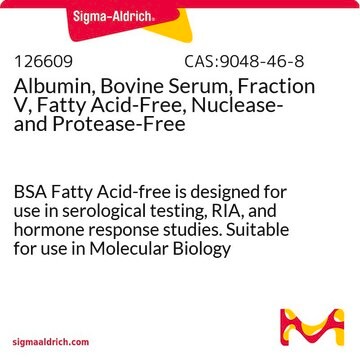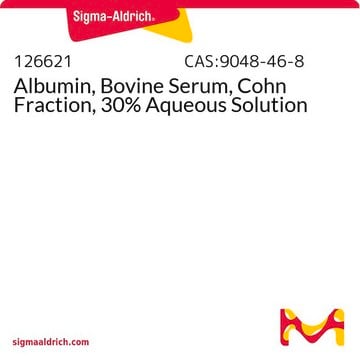126575
Albumin, Bovine Serum, Fraction V, Fatty Acid-Free
Synonym(s):
Albumin, Bovine Serum, Fraction V, Fatty Acid-Free
Sign Into View Organizational & Contract Pricing
All Photos(1)
About This Item
Recommended Products
Assay
≥95% (cellulose acetate electrophoresis)
form
powder
manufacturer/tradename
Calbiochem®
storage condition
OK to freeze
impurities
≤0.02% fatty acids
≤3% ash
≤5% moisture
color
white to light yellow
light yellow to light brown
shipped in
ambient
storage temp.
2-8°C
General description
Albumin, Bovine Serum, (BSA) Fraction V, Fatty Acid-Free is useful for immunodiagnostic assays. It is designed for use in serological testing, radioimmunoassay, and hormone response studies. It is also applicable in binding and transport studies. BSA is prepared by cold ethanol extraction (Cohn method) with a pH: 6.8-7.4.
Bovine serum albumin (BSA) is a non-glycosylated globular, α-helical protein belonging to the serum albumin family. It consists of three domains with two sub-domains each and has 17-disulfide bonds.
Application
Albumin, Bovine Serum, Fraction V, Fatty Acid-Free has been used:
- as a component of: blocking buffer immunoelectron microscopy (IEM) for various cells
- mitochondrial isolation buffer (MIB) and mitochondria assay solution (MAS) to trap free fatty acids released during adipose tissue homogenization
- blocking buffer for wholemount staining of the esophageal epithelium (EE) in immunofluorescence
Biochem/physiol Actions
Bovine Serum Albumin (BSA), the most vital component of cell culture media, aids in embryonic stem cells (hESC) differentiation. It aids the transportation of drugs, hormones, and fatty acids. BSA is also used as a blocking agent in enzyme-linked immunosorbent assay (ELISA).
Warning
Toxicity: Standard Handling (A)
Preparation Note
May take up to 24 h to fully dissolve.
Reconstitution
Following reconstitution, store in the refrigerator (4°C). 0.1% NaN₃ may be added as a preservative. Stock solutions are stable for up to 3 months at 4°C.
Legal Information
CALBIOCHEM is a registered trademark of Merck KGaA, Darmstadt, Germany
Storage Class Code
11 - Combustible Solids
WGK
WGK 3
Flash Point(F)
Not applicable
Flash Point(C)
Not applicable
Certificates of Analysis (COA)
Search for Certificates of Analysis (COA) by entering the products Lot/Batch Number. Lot and Batch Numbers can be found on a product’s label following the words ‘Lot’ or ‘Batch’.
Already Own This Product?
Find documentation for the products that you have recently purchased in the Document Library.
Customers Also Viewed
M Prats
European journal of biochemistry, 75(2), 619-625 (1977-05-16)
The L-(+)-Lactate:cytochrome c oxidoreductase or cytochrome b2 from the yeasts Saccharomyces cerevisiae and Hansenula anomala were partially hydrolysed in various concentrations of trypsin. Conditions were found which allowed the isolation from the Hansenula enzyme of a 140 000 +/- 10
Mohyeddine Omrane et al.
iScience, 13, 138-153 (2019-03-05)
Septins are GTP-binding proteins involved in several membrane remodeling mechanisms. They associate with membranes, presumably using a polybasic domain (PB1) that interacts with phosphoinositides (PIs). Membrane-bound septins assemble into microscopic structures that regulate membrane shape. How septins interact with PIs
Soyeon Park et al.
Experimental & molecular medicine, 50(8), 1-14 (2018-08-05)
Increased fatty acid (FA) is often observed in highly proliferative tumors. FAs have been shown to modulate the secretion of proteins from tumor cells, contributing to tumor survival. However, the secreted factors affected by FA have not been systematically explored.
Andrew W Ferree et al.
Autophagy, 9(11), 1887-1896 (2013-10-24)
To study mitochondrial protein age dynamics, we targeted a time-sensitive fluorescent protein, MitoTimer, to the mitochondrial matrix. Mitochondrial age was revealed by the integrated portions of young (green) and old (red) MitoTimer protein. Mitochondrial protein age was dependent on turnover
Abdellah Akil et al.
Nature communications, 7, 12203-12203 (2016-07-16)
The accumulation of lipid droplets (LD) is frequently observed in hepatitis C virus (HCV) infection and represents an important risk factor for the development of liver steatosis and cirrhosis. The mechanisms of LD biogenesis and growth remain open questions. Here
Our team of scientists has experience in all areas of research including Life Science, Material Science, Chemical Synthesis, Chromatography, Analytical and many others.
Contact Technical Service










